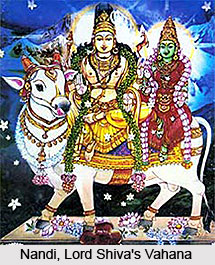 Nandi is an independent deity. He is considered as the bull of the ancient times - the Lord of Joy, Nandikeshvara. He was represented as a man with a bull`s head. However later it was said that Nandikeshvara was a wise man. Nandi is Lord Shiva`s vehicle. He embodies permanent inner strength which is acquired by controlling violence and physical strength.
Nandi is an independent deity. He is considered as the bull of the ancient times - the Lord of Joy, Nandikeshvara. He was represented as a man with a bull`s head. However later it was said that Nandikeshvara was a wise man. Nandi is Lord Shiva`s vehicle. He embodies permanent inner strength which is acquired by controlling violence and physical strength.
This animal has some similarity with Lord Vishnu`s Garuda. Originally, it was known by the name Nandikeshvara and it is said to have existed in human form as a rishi (sage), who belonged to Shiva`s attendants. He sometimes acted as Shiva`s door-keeper. Nandi is represented on a pedestal crouching in front of the Shiva temples. It s said that the head of Nandi is turned towards the small door of the shrine. It is said that every Sanskrit play opens with one or more Nandis, in which the blessing of some deity is invoked on the audience.
Legends of Nandi
According to the Indian Puranas, Nandi achieved divine or semi-divine status in various ways. These include his recognition as another form of Shiva from whom, in some cases, his representations are sometimes almost impossible to differentiate. In the form of rishi, Nandi can be seen at the entrance to Shiva temples. But, he is seen in the form of a bull more frequently. According to the legends, it is said that Prajapati Brahma gave Nandi bull to Shiva or he took the form of a bull to represent Dharma and stood for the salvation of departed souls on the other side of death. The association of Lord Shiva with Nandi bull can be due to his relationship with Rudra, who was sometimes referred to as a bull. This may have its roots in the mythology. Earlier, the bulls were found in ancient scriptures, which have contributed to the civilisations of different countries. The universal strength of Lord Shiva can be linked with his association with Nandi bull.
Nandi is painted as pure white with a well rounded body, large brown eyes, heavy shoulders, shining coat and black tail. The lump of Nandi is drawn like the top of a snow-capped mountain and he should have a golden belt round his body and sharp horns with red points.




















